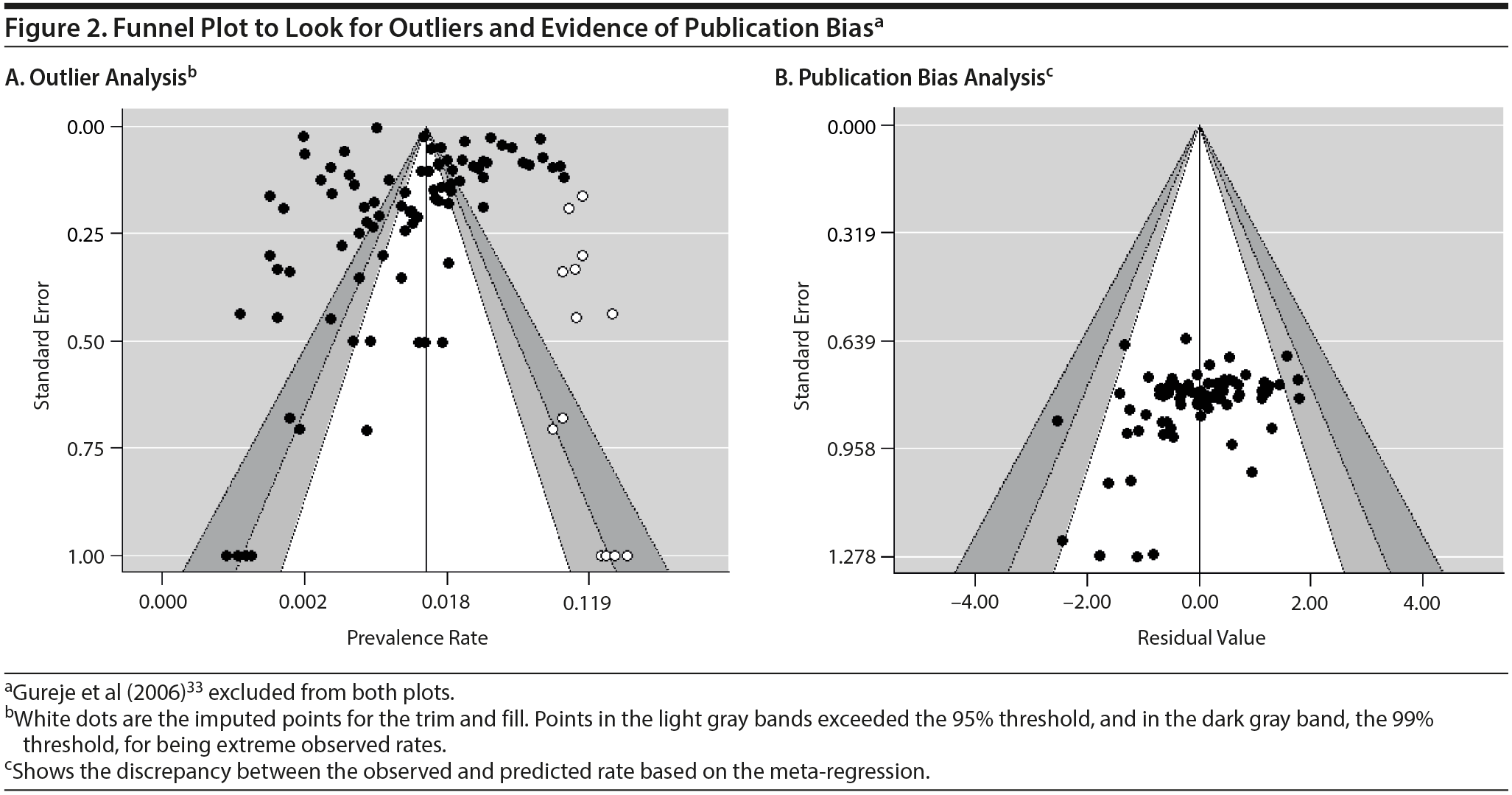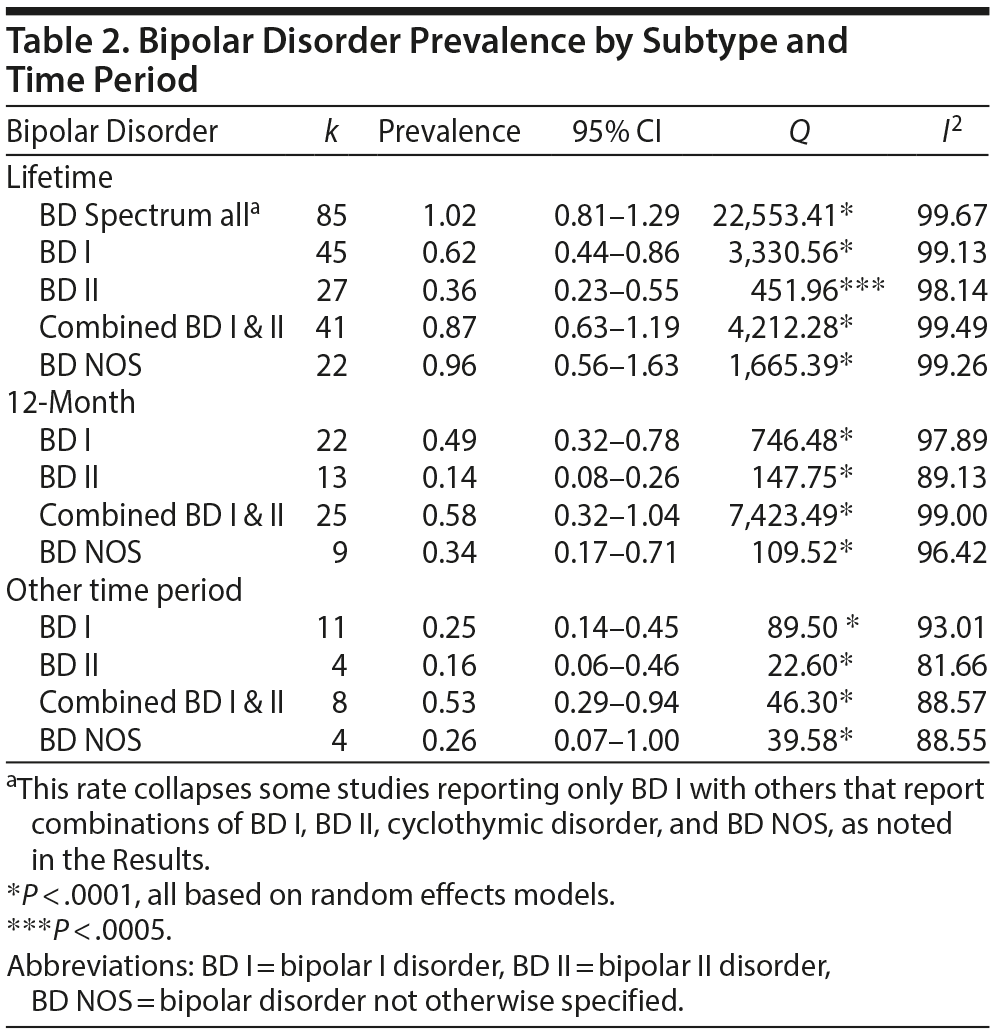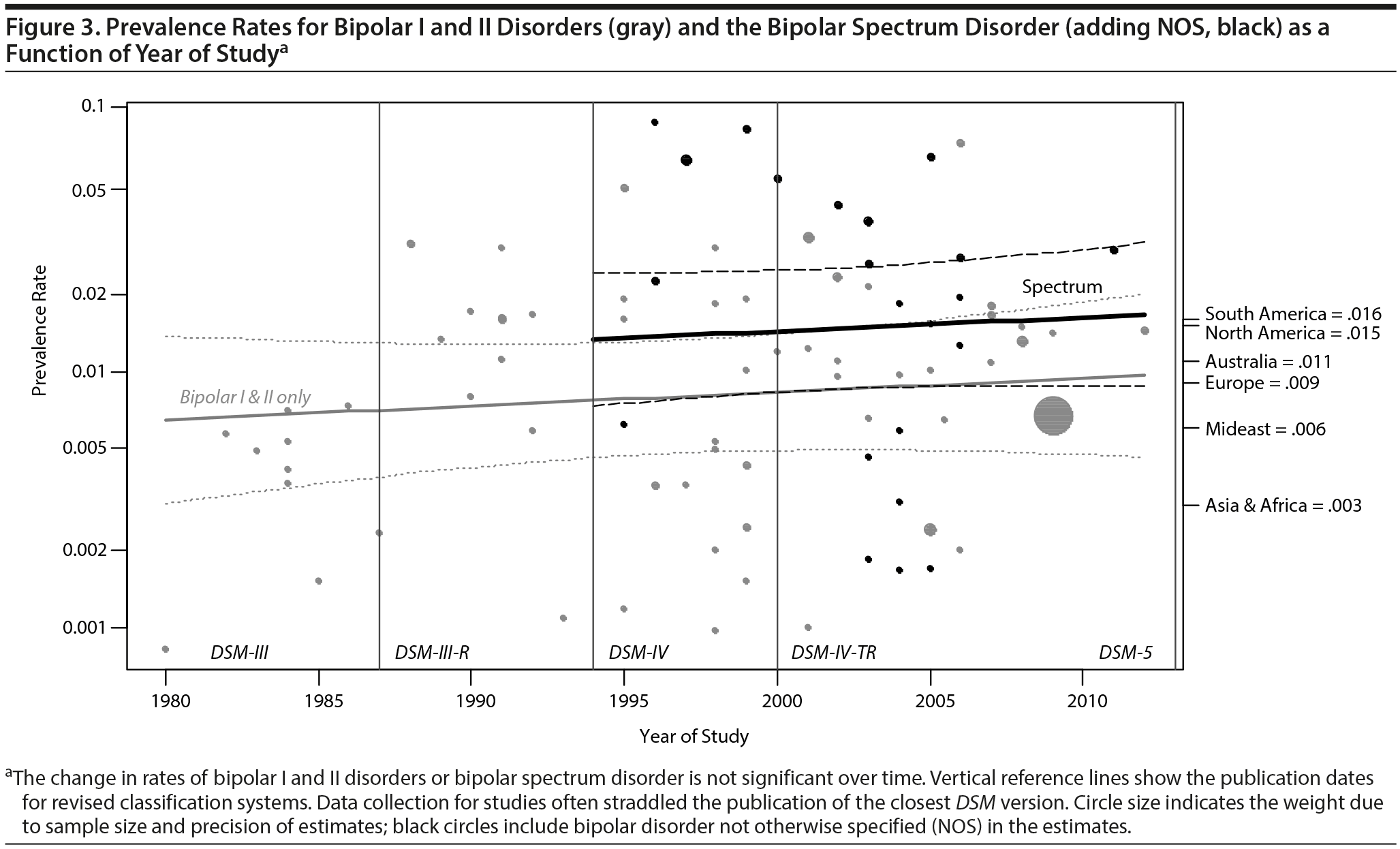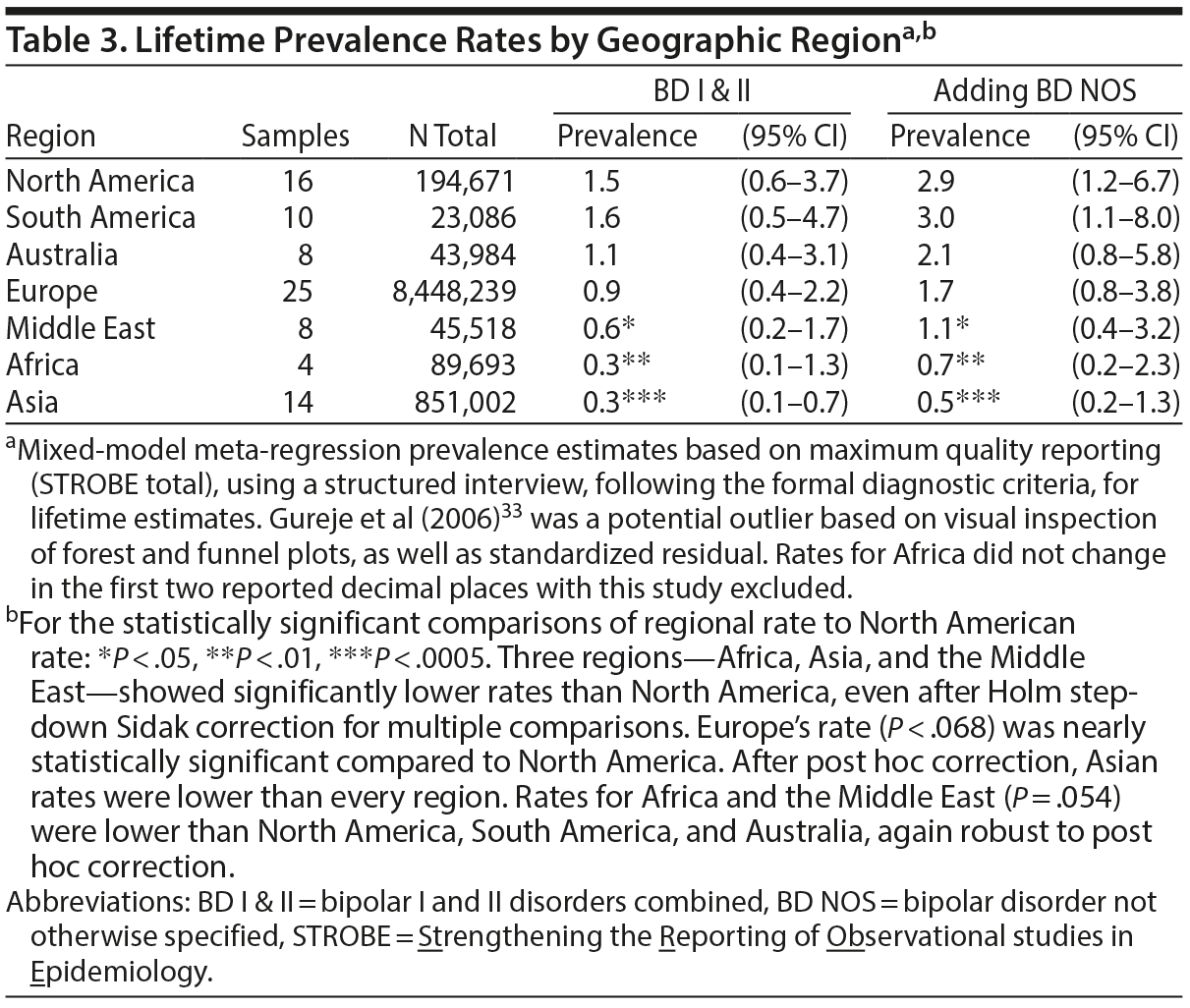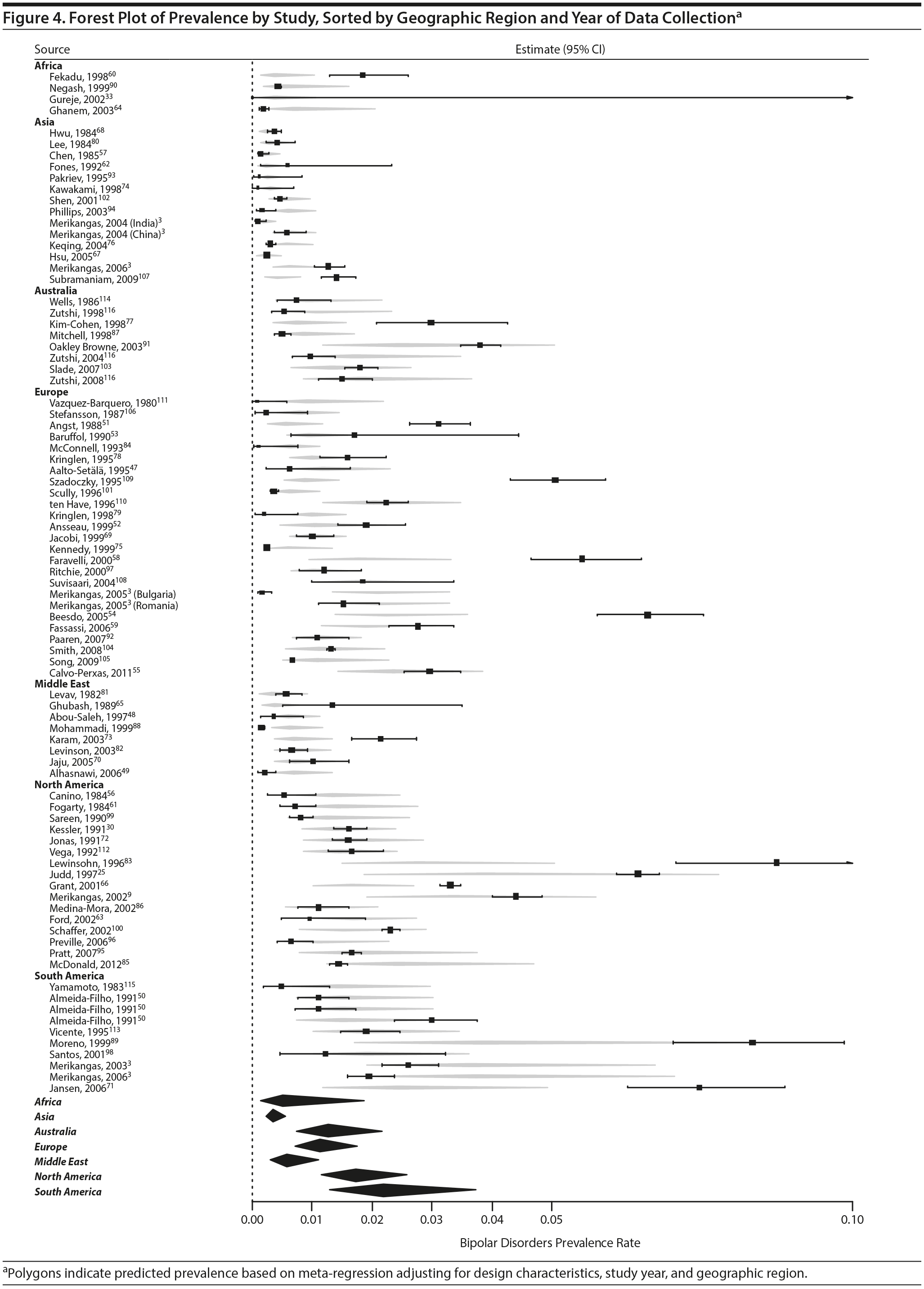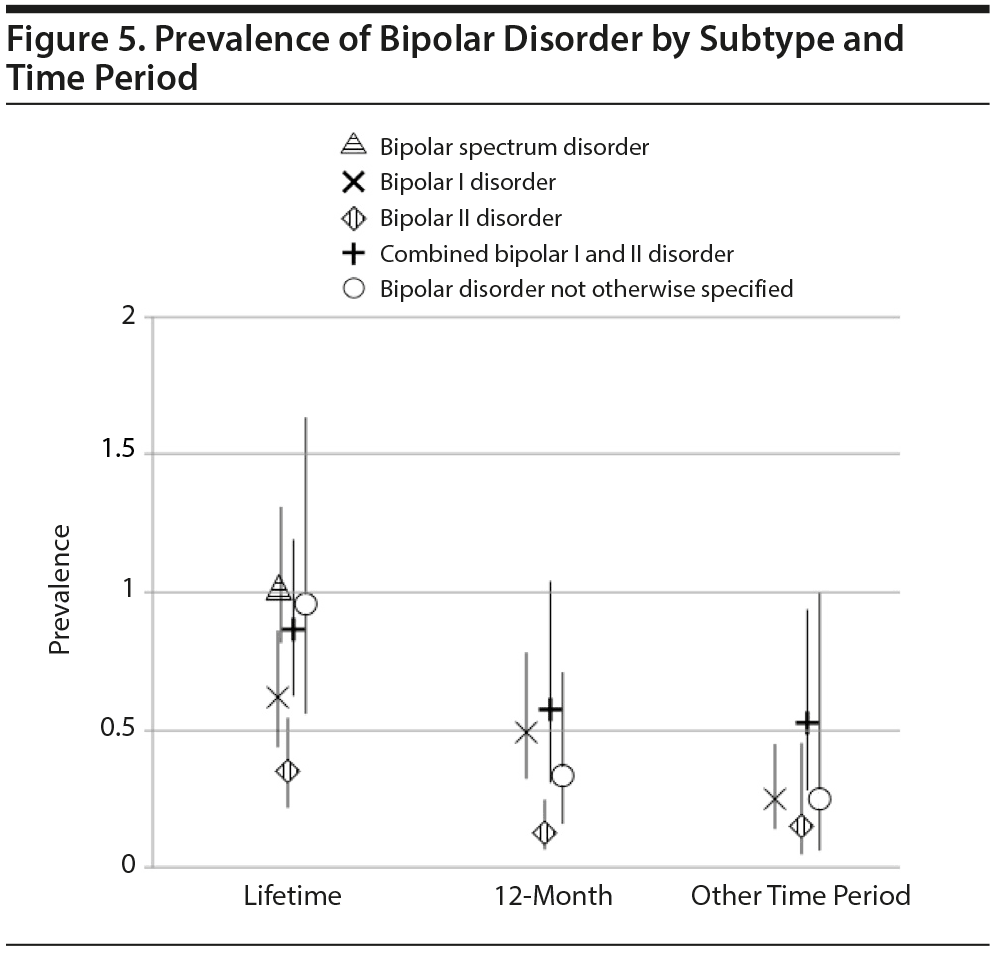Objective: To test whether rates of bipolar disorder (BD) have changed over time or vary across geographic regions after adjusting for design features meta-analyzing epidemiologic studies reporting BD prevalence in adults worldwide.
Data Sources: Searches in PubMed and PsycINFO using the terms (epidemiology OR community OR prevalence) AND (mania OR “bipolar disorder” OR cyclothymi*) AND adult and backward searches from published reviews were conducted.
Study Selection: Eighty-five epidemiologic studies published in English from 1980 onward that reported prevalence rates for BD or mania for subjects ≥ 18 years old were included.
Data Extraction: We coded BD prevalence, method of data collection, diagnostic criteria, year of study, country, and quality of study design and data reporting. Meta-regression tested whether sample characteristics influenced prevalence rates using the metafor package in R.
Results: Eighty-five effect sizes, from 44 countries, from studies spanning the years 1980-2012, included 67,373 people with BD. Lifetime prevalence for BD spectrum was 1.02% (95% CI, 0.81%-1.29%). Prevalence was moderated by the inclusion of BD not otherwise specified (P = .009) and by geographic region; rates from Africa and Asia were less than half of those from North and South America. Rates did not change significantly over 3 decades after controlling for design features.
Conclusions: The overall prevalence rate is consistent with historical estimates, but rates vary significantly across studies. Differences in methodology contribute to the perception that rates of BD have increased over time. Rates varied markedly by geographic region, even after controlling for all other predictors. Research using consistent definitions and methods may expose specific factors that confer risk for BD.
See free commentary by Weissman

Review and Meta-Analysis of Epidemiologic Studies of Adult Bipolar Disorder

ABSTRACT
Objective: To test whether rates of bipolar disorder (BD) have changed over time or vary across geographic regions after adjusting for design features meta-analyzing epidemiologic studies reporting BD prevalence in adults worldwide.
Data Sources: Searches in PubMed and PsycINFO using the terms (epidemiology OR community OR prevalence) AND (mania OR “bipolar disorder” OR cyclothymi*) AND adult and backward searches from published reviews were conducted.
Study Selection: Eighty-five epidemiologic studies published in English from 1980 onward that reported prevalence rates for BD or mania for subjects ≥ 18 years old were included.
Data Extraction: We coded BD prevalence, method of data collection, diagnostic criteria, year of study, country, and quality of study design and data reporting. Meta-regression tested whether sample characteristics influenced prevalence rates using the metafor package in R.
Results: Eighty-five effect sizes, from 44 countries, from studies spanning the years 1980-2012, included 67,373 people with BD. Lifetime prevalence for BD spectrum was 1.02% (95% CI, 0.81%-1.29%). Prevalence was moderated by the inclusion of BD not otherwise specified (P = .009) and by geographic region; rates from Africa and Asia were less than half of those from North and South America. Rates did not change significantly over 3 decades after controlling for design features.
Conclusions: The overall prevalence rate is consistent with historical estimates, but rates vary significantly across studies. Differences in methodology contribute to the perception that rates of BD have increased over time. Rates varied markedly by geographic region, even after controlling for all other predictors. Research using consistent definitions and methods may expose specific factors that confer risk for BD.
J Clin Psychiatry 2017;78(9):e1259-e1269
https://doi.org/10.4088/JCP.16r11165
© Copyright 2017 Physicians Postgraduate Press, Inc.
aDepartment of Psychiatry, Centro Hospitalar do Oeste, Caldas da Rainha, Portugal
bFaculty of Medicine, Universidade de Lisboa, Lisbon, Portugal
cFerkauf Graduate School of Psychology at Yeshiva University, New York, New York
dDepartment of Psychology, University of North Carolina Chapel Hill, Chapel Hill, North Carolina
*Corresponding author: Eric A. Youngstrom, MD, Department of Psychology and Neuroscience, Davie Hall, CB 3270 University of North Carolina Chapel Hill, Chapel Hill, NC 27599 ([email protected]).
Bipolar disorder (BD) is a leading cause of burden worldwide1 and contributes significantly to premature death: the suicide risk in BD subjects is up to 30 times higher than the general population,2 with 1 in 4 or 5 people attempting suicide.3 Moreover, people with BD are at high risk for physical illness.4-6 Comorbid psychiatric illnesses are also common, including alcohol and other substance use disorders that are likely to increase impairment and medical costs.7-9 Obesity, heart disease, and cancer are not uniformly distributed around the world, due to both differences in biological risk, such as genetic epidemiology, and variations in diet and environmental factors. Psychiatric genetic epidemiology is revealing that some of the high risk single-nucleotide polymorphisms are relatively recent mutations not uniformly distributed around the world,10,11 and differences in the prevalence of BD worldwide have sparked interest in omega-3 fatty acids and other nutrients as potential modifiers of risk and course.12,13 For all these reasons, it would be valuable to compare rates of BD systematically across different regions of the world.
Rates of clinical diagnoses of BD have varied substantially over time,14 raising questions about whether the disease is becoming more common,14-18 versus correcting for past underdiagnosis19 or representing a misguided bubble in diagnostic practice driven by marketing and fashion.20 Both clinical and community studies offer important information about the prevalence of BD; the clinical prevalence of BD provides an estimate of cases sick enough—and with enough resources—to receive treatment,21,22 whereas epidemiologic studies may offer a more accurate estimate of the true prevalence of BD, independent of treatment-seeking behavior or access to mental health care. Increasing rates of clinical diagnoses have led to interest in whether epidemiologic rates of BD have also increased, which would indicate a concerning shift in risk rather than a change in diagnostic practices. Vignette studies and ratings of recorded interviews reveal that a large amount of variance in diagnostic practices is due to differences in training and case formulation—clinicians interpret exactly the same clinical presentation as reflecting different diagnoses or substantially different severity of manic symptoms.23,24 Differences in prevalence can also be attributed to investigators’ idiosyncratic use of DSM or ICD criteria.25,26 For example, higher rates of BD in the National Comorbidity Survey were attributed to the inclusion of cases based on irritability, rather than elated mood.27 Thus, it is crucial to use consistent interview methods and definitions, or at least to calibrate them, before meaningful trends in clinical and/or epidemiologic prevalence can be discerned. Importantly, efforts have been made to standardize the recruitment and diagnostic methods in recent international collaborations,3 but this remains the exception, rather than the rule.
Although DSM and ICD have generally described rates of bipolar disorder as being fairly consistent globally, epidemiologic studies from western countries generally find rates between 1% and 4% for the bipolar spectrum,3,28-31 whereas studies from Asian and African countries tend to be somewhat lower, ranging between 0.09%32 and 1.26%3 in Asia and between 0%33 and 5.36%34 in Africa. However, these studies were done during different decades, under the purview of different versions of nosologic criteria. Since its introduction in the second edition of the DSM35 as manic depressive illness, the criteria and subtypes for BD have changed, meaning that a wider range of symptom presentations meet diagnostic criteria today than would have in 1968.36,37 The number of subtypes of bipolar disorder has increased, with DSM-III-R moving bipolar II to the main section and DSM-IV adding “not otherwise specified” (NOS). NOS has been substantially more common than bipolar I in epidemiologic and clinical samples, while also amassing substantial evidence of associated impairment. Including NOS in the operational definition of BD can double or triple the estimate, confounding the timing of the study with the definition used (only more recent studies could include NOS, though not all recent studies do). The methods used to make diagnoses have also changed over time and can vary from study to study; structured clinical interviews may lead to different results than unstructured interviews or self-report measures.38,39 Considering symptoms across the lifespan, rather than just in the past year, will also affect rates.40 For the epidemiologic literature to address fundamental questions such as whether there are regional differences in rates of BD, or whether the rates of BD have changed over time, it is crucial to adjust for differences in methodology and definition.
Our primary aim was to determine the overall prevalence rate of bipolar spectrum disorders across adult samples, as well as specific rates for BD I, BD II, BD I and II combined, and BD NOS, for lifetime, 12 months, and other time periods. A second aim of our study was to test whether rates have changed significantly over time after adjusting for methodological factors. Another aim was to test whether there were significant regional differences in rates of BD after adjusting for definitions and methodological characteristics. Predictors of interest included (1) whether the full spectrum of BD subtypes was included in the study; (2) year of data collection, as there has been debate about secular trends increasing the rate of BD; and (3) geographic region (dummy codes with North America as the reference group). Additionally, we evaluated (1) whether the study used DSM or ICD criteria as written, because idiosyncratic criteria can narrow or expand the number of cases considered BD; (2) whether a structured interview was used—structured interviews provide both more reliable and more accurate diagnoses38-41; (3) whether diagnoses were based on lifetime symptoms, considering that symptoms over the whole lifespan are likely to yield higher—and arguably more accurate—estimates, given the episodic nature of BD; and (4) design and reporting quality, coded via the STROBE (Strengthening the Reporting of Observational Studies in Epidemiology) checklist42 scores, as studies reporting more complete information and less subject to biases may be associated with different rates.

- In spite of popular perception, the prevalence of bipolar spectrum disorders has not increased over time. However, the prevalence of bipolar spectrum disorders does vary significantly by geographic region.
- Research using consistent diagnostic definitions and methods is important to identify specific factors that confer risk for BD.
METHODS
Search Strategy
Searches of PubMed and PsycINFO used the terms (epidemiology OR community OR prevalence) AND (mania OR “bipolar disorder” OR cyclothymi*) AND adult. Reference lists from related articles and chapters were combed for other relevant studies. Epidemiologic studies published in English after 1980 (coinciding with DSM-III) that reported prevalence rates for BD or mania for subjects ≥ 18 years old were included. Authors made a consensus decision about any study with ambiguity about inclusion; see Figure 1. Some articles reported on more than 1 site of data collection; in such cases, all reported effect sizes (prevalence rates) were included in the meta-analysis. When more than 1 study reported on the same sample, we chose the effect size associated with the most recent and/or complete data from a given study. The search was updated May 2016.
Study Coding
Data extraction and coding followed the same methods as a previous meta-analysis of the prevalence of pediatric BD,26,43 capturing data on prevalence of BD subtypes, sample demographic data, method of attainment, quality of design and of reporting, and country variables. Quality of design and reporting was evaluated using the STROBE checklist.42 The first and second authors coded all studies. Reliability was calculated using κ for categorical and intraclass correlation for absolute agreement for continuous variables; reliability coefficients ranged from 0.86 to 1.00, with a median of 1.00.
Meta-Analysis
The prevalence of bipolar spectrum cases was based on the number of cases of BD (depending on subtype) out of the full sample size for each study. We used the metafor package in R44 to meta-analyze the data. Prevalence rates were transformed using logit transformation,45 in order to normalize the data distribution, with inverse variance weighting. A random effects model estimated the average weighted prevalence for overall bipolar rate,* in addition to BD I, BD II, BD combined,‘ and BD NOS, for lifetime, 12-month, and < 12-month time periods. We chose not to estimate separate prevalence rates for cyclothymic disorder; even though this is a prevalent illness associated with serious functional impairments, only 3 studies reported Ns that could be meta-analyzed. We also calculated prevalence rates for geographic regions separately. Cochran Q statistic assessed whether prevalence rates were homogeneous across samples, and the I2 statistic measured the percentage of variability in prevalence rates that was due to true heterogeneity.46 Mixed-effects meta-regression tested whether prevalence of BD changed over time or across regions, controlling for definitions used and other design features.
RESULTS
The search netted a total of 85 effect sizes from 44 different countries, from studies conducted from 1980 to 2012, covering 67,373 cases with BD, out of a total of 9,696,193 participants. This suggests a raw prevalence of 0.7% (ie, 67,373/9,696,193), but that would be biased either as an estimate of BD I (because it includes other bipolar diagnoses) or as a bipolar spectrum estimate (because many studies focused only on bipolar I). Table 1 lists all the studies included in the analyses. Funnel plots and Egger test indicated publication bias, with a tendency to omit studies with higher rates (see Figure 2).
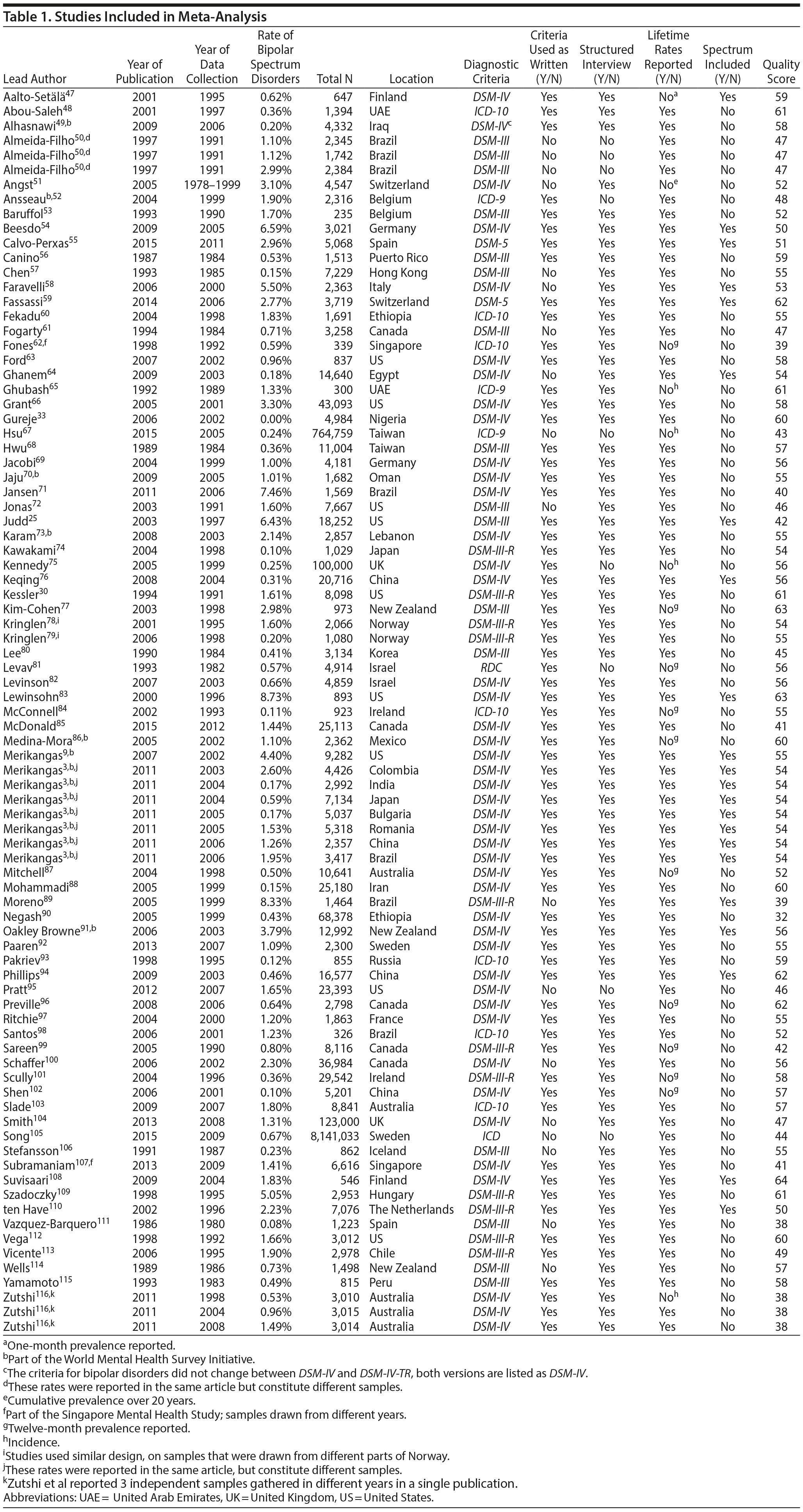
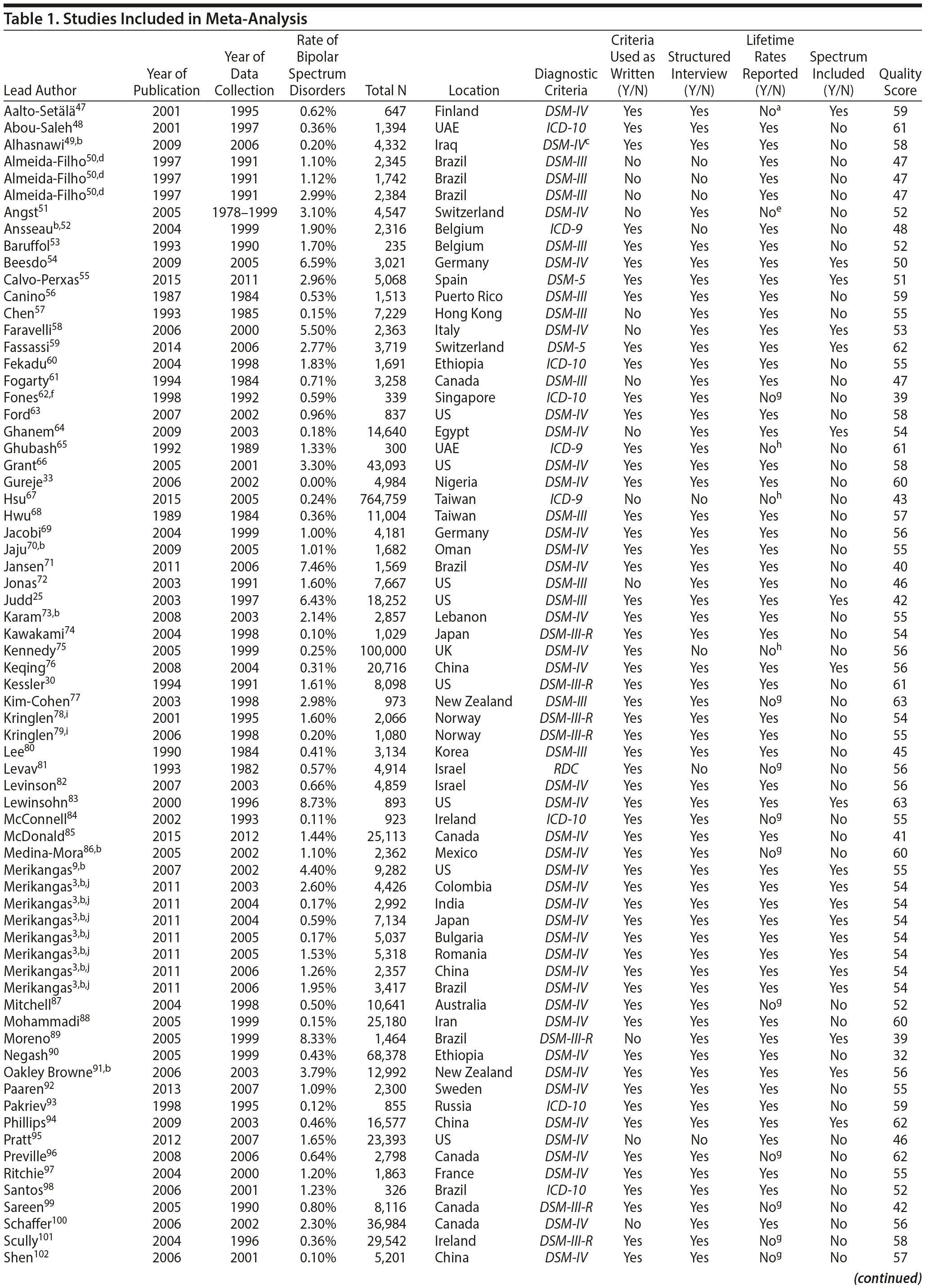

What Is the BD Spectrum Prevalence Worldwide?
The overall prevalence for bipolar spectrum disorders across studies, based on a random effects model, was 1.02% (95% CI, 0.81%-1.29%). Simple trim and fill adjustment suggested that the rate would rise to 1.34% with imputation of the “missing” studies implied in the funnel plot. There was significant heterogeneity between studies (Q = 22,553.41, df = 84, P < .0001; H2 = 301.98, I2 > 99%); see Table 2. Mixed effects meta-regression tested whether hypothesized moderators influenced the overall bipolar spectrum disorder prevalence rate. The inclusion of bipolar subtypes other than BD I and II was associated with higher prevalence rates (P = .009; 95% CI, B = 0.17 to 1.20). The other design features (STROBE score, lifetime prevalence, use of structured interview, following strict nosologic definitions) did not account for unique incremental heterogeneity when included together in the meta-regression (Qm = 3.86, df = 4, P = .425). We also used a meta-analysis multivariate model to test whether prevalence was influenced by the fact that some studies were nested within collaborative projects3,25 and, consequently, shared a majority of design features; the amount of variance accounted for within consortia was not significant.
After controlling for design features, there was no significant association between study year and rate of BD (z = 0.71, P = .479). Had we not adjusted for design features, there would seem to be a trend for rates to increase (B = 0.03, z = 1.79, P = .074). However, the apparent trend could be attributed to the introduction of NOS as a category, resulting in significantly higher rates in studies that included NOS; see Figure 3.
In contrast, regional differences in rates accounted for large amounts of heterogeneity between studies, even after adjusting for year, definition of BD, and other design features (Qm = 34.56, df = 6, P < .00005). The full meta-regression explained 37% of the variance in rates across studies, with regional differences accounting for 27% of the variance and the other predictors, for 10%. Table 3 presents the regional rates for BD I and II, as well as the rates including BD NOS, controlling for design features. The rates for Asia and Africa are significantly lower than almost all other regions, and North and South America and Australia have the highest rates, with most differences between regions remaining significant after post hoc correction. Regional estimates also appear at the bottom of the forest plot shown in Figure 4. Residual heterogeneity was significant (QE = 2,731.76, df = 72, P < .0001; H2 = 69.0, I2 = 98.6%), suggesting that there are important moderators of BD prevalence beyond those measured in the study. Examination of standardized residuals, Cook d, and other regression diagnostics found no influential outliers. Gureje et al33 was a borderline outlier; excluding it did not change any of the results to the second decimal place due to its low weight.
Table 2 and Figure 5 report prevalence rates for BD I, BD II, BD I and II combined, and BD NOS (lifetime, 12 month, <12 month other time period). Again, rates were highly heterogeneous; P values < .0001.
DISCUSSION
The goal of the present study was to use meta-regression to determine the influence of key design features on the epidemiologic prevalence rates of bipolar disorder, including operational definition of bipolar disorder and interview type, and then to test whether the rates of BD were changing significantly over time or whether they varied regionally. The inclusion of BD NOS was the most important design feature, accounting for significantly higher prevalence estimates. After accounting for design features, there was no significant time trend in the rates of BD. However, there were large regional differences in rates of BD.
International Prevalence of BD
The results show that rates of BD vary widely internationally. The 7 regions fell into roughly 3 groups. High prevalence regions included North and South America and Australia; Asia and Africa were low prevalence regions, and the Middle East and Europe were moderate. The differences were substantial, with the high prevalence regions having rates of both BD I/II or BD spectrum (including NOS) that doubled the low prevalence regions. These differences remained after controlling for design features and after post hoc correction. Our results were consistent with other data suggesting that prevalence rates vary internationally, with western countries reporting higher rates than African or Asian countries.22,33,117 Myriad variables might influence differences internationally, including cultural differences in the experience of symptoms, stigma against talking about psychological problems, prevalence of risk factors, and access to mental health care. It is possible that, as western culture permeates other cultures, important differences in risk will be eliminated. There is a certain degree of urgency, given rapid globalization, to learn more about the factors that drive these differences in prevalence, in order to determine whether there are protective agents we might be able to capitalize on to reduce the prevalence of BD worldwide.
Influence of Study Design
As expected, those studies that included subtypes of bipolar disorder other than just BD I or II tended to have higher prevalence rates. This is consistent with other studies that have found that the “subthreshold” subtypes—cyclothymic disorder and BD NOS (now “other specified bipolar and related disorder”)—are more prevalent than BD I or II.26,118 Only about a quarter of studies included BD NOS, and only 5% included cyclothymic disorder. This is not surprising, but it does mean that we know the least about the bipolar spectrum subtypes that affect the highest number of people.119
We were surprised that our hypothesis that the use of a structured interview would affect the BD prevalence rate was not supported. Previous studies have found higher rates of illness using structured interviews.27 However, the majority of studies in our sample did use a structured interview (72/85), so lack of variability may have reduced our ability to find an effect. Had we chosen to include studies prior to 1980, when contemporary definitions of bipolar spectrum disorders were introduced, there would have been a greater number of studies that did not use structured interviews. Relatedly, our hypothesis that idiosyncratic use of diagnostic criteria would influence prevalence might have been supported; it is a positive sign that there has been a concerted effort in recent years to establish guidelines42,120 and to collaborate internationally in order to more accurately map similarities and differences in rates of mental illness.3
We had expected that those studies that used lifetime symptoms in determining a diagnosis would report higher prevalence rates, but this hypothesis was not supported. This may be because those studies that did not report on lifetime rates primarily reported on 12-month rates, and most people with BD will experience symptoms over the course of a year. Additionally, the “other” time period category in our study included anything less than a year, which may not have provided the same level of contrast in rates that incidence rates would have, for example.
Strengths of the Study
The present study is the largest meta-analysis conducted on prevalence rates of BD. Eighty-five studies conducted between 1980 and 2012, from 44 different countries, including 9,696,193 people. We were able to explore the prevalence rates for BD II, cyclothymic disorder, and BD NOS as well as BD I. Although many studies focused on BD I, all subtypes can cause considerable impairment, and the “subthreshold” subtypes—BD NOS and cyclothymic disorder—appear at least as prevalent as BD I or II.26
The large number of studies included in this meta-analysis allowed us to use mixed-effects meta-regression to test whether hypothesized factors and design features influence prevalence. Importantly, the results of the meta-regression also challenge perceptions that the prevalence of BD has been increasing over time, consistent with a previous meta-analysis of the prevalence of BD in youth.26 Prior narrative reviews of the literature may not have systematically adjusted for changes in definitions over time and other design features.
Limitations
Meta-analyses can be only as good as the studies they include43; although the number of studies we analyzed is a strength, it also introduces wide variability in terms of how BD is defined, the subtypes and time period assessed, the quality of the design, and other potential moderating factors. Meta-regression quantified the influence of sample and design characteristics that were reported, but other important factors were not reported consistently or at all (including demographic characteristics of interest). Additionally, although we had hypotheses about specific design features (ie, type of interview, bipolar definition) and about sample characteristics (ie, date of data collection, location), these attributes were often collinear, obscuring our ability to detect and interpret differences. Substantial heterogeneity remained even after controlling for all measured predictors; without standard recruitment and diagnostic methods across samples, the inferences to be drawn from meta-analyses will remain limited by the “noise” introduced by study variability. Finally, our sample represents 44 countries, but we included only papers published in English, perhaps limiting our ability to fully represent global epidemiologic data.
Conclusion and Future Directions
The results suggest that the inclusion of BD NOS significantly increases the rate of BD, roughly doubling the estimates. The relatively recent addition of BD NOS to research studies contributes to the perception of higher rates of BD over time, and the time trend was no longer significant after controlling for BD definition and study design features. Most importantly, the meta-analysis confirmed large differences in regional rates of BD, even after adjusting for all other measured factors. Although the difference in rates contradicts earlier generalizations in nosologic systems, it is broadly consistent with emerging findings in psychiatric genetic epidemiology,9 as well as the epidemiology of cardiovascular disease and obesity121: Risky variants of genes and environmental factors are not uniformly distributed globally, nor are the common medical comorbidities that are associated with BD. We hope that newer studies will provide a fuller accounting for the bipolar spectrum in their reports, using consistent definitions and strong methodology, as well as adding information about biological and environmental factors to help unpack the substantial regional differences in risk.
Submitted: August 23, 2016; accepted March 27, 2017.
Published online: November 28, 2017.
Potential conflicts of interest: Dr Moreira is currently involved in a Boehringer Ingelheim clinical trial. Dr Youngstrom has consulted with Pearson, Janssen, Otsuka, Lundbeck, Joe Startup Technologies, and Western Psychological Services about psychological assessment. The authors report no competing interests.
Funding/support: Dr Moreira was supported by fellowships from Fulbright and the Fundaç×£o para a Ciência e a Tecnologia-Portugal (SFRH/BD/38246/2007).
Role of the sponsor: The authors thank the funding institutions for having strongly facilitated the collaboration between Dr Moreira and Drs Van Meter and Youngstrom, which was particularly important in the design and collecting of data for the study.
Previous presentations: Preliminary findings were presented as part of an Expert Workshop at the 10th International Review of Bipolar Disorders in May 2010 in Budapest, Hungary, and at the 18th Annual Conference of The International Society for Bipolar Disorders held jointly with the 8th Biennial Conference of The International Society for Affective Disorders in July 2016 in Amsterdam, The Netherlands.
REFERENCES
1. World Health Organization. The Global Burden of Disease: 2004 Update. Geneva, Switzerland: World Health Organization; 2008.
2. Pompili M, Gonda X, Serafini G, et al. Epidemiology of suicide in bipolar disorders: a systematic review of the literature. Bipolar Disord. 2013;15(5):457-490. PubMed CrossRef
3. Merikangas KR, Jin R, He JP, et al. Prevalence and correlates of bipolar spectrum disorder in the World Mental Health Survey initiative. Arch Gen Psychiatry. 2011;68(3):241-251. PubMed CrossRef
4. Buhagiar K, Parsonage L, Osborn DP. Physical health behaviours and health locus of control in people with schizophrenia-spectrum disorder and bipolar disorder: a cross-sectional comparative study with people with non-psychotic mental illness. BMC Psychiatry. 2011;11(1):104. PubMed CrossRef
5. De Hert M, Cohen D, Bobes J, et al. Physical illness in patients with severe mental disorders, II: barriers to care, monitoring and treatment guidelines, plus recommendations at the system and individual level. World Psychiatry. 2011;10(2):138-151. PubMed CrossRef
6. Pini S, de Queiroz V, Pagnin D, et al. Prevalence and burden of bipolar disorders in European countries. Eur Neuropsychopharmacol. 2005;15(4):425-434. PubMed CrossRef
7. Hirschfeld RM, Vornik LA. Bipolar disorder—costs and comorbidity. Am J Manag Care. 2005;11(suppl):S85-S90. PubMed
8. Kleinman L, Lowin A, Flood E, et al. Costs of bipolar disorder. Pharmacoeconomics. 2003;21(9):601-622. PubMed CrossRef
9. Merikangas KR, Akiskal HS, Angst J, et al. Lifetime and 12-month prevalence of bipolar spectrum disorder in the National Comorbidity Survey replication. Arch Gen Psychiatry. 2007;64(5):543-552. PubMed CrossRef
10. Petryshen TL, Sabeti PC, Aldinger KA, et al. Population genetic study of the brain-derived neurotrophic factor (BDNF) gene. Mol Psychiatry. 2010;15(8):810-815. PubMed CrossRef
11. Chen C, et al. Population migration and the variation of dopamine D4 receptor (DRD4) allele frequencies around the globe. Evol Hum Behav. 1999;20(5):309-324. CrossRef
12. Hibbeln JR. Fish consumption and major depression. Lancet. 1998;351(9110):1213. PubMed CrossRef
13. Kapusta ND, Mossaheb N, Etzersdorfer E, et al. Lithium in drinking water and suicide mortality. Br J Psychiatry. 2011;198(5):346-350. PubMed CrossRef
14. Moreno C, Laje G, Blanco C, et al. National trends in the outpatient diagnosis and treatment of bipolar disorder in youth. Arch Gen Psychiatry. 2007;64(9):1032-1039. PubMed CrossRef
15. Post RM, Leverich GS, Altshuler LL, et al. Differential clinical characteristics, medication usage, and treatment response of bipolar disorder in the US versus The Netherlands and Germany. Int Clin Psychopharmacol. 2011;26(2):96-106. PubMed CrossRef
16. Gershon ES, Hamovit JH, Guroff JJ, et al. Birth-cohort changes in manic and depressive disorders in relatives of bipolar and schizoaffective patients. Arch Gen Psychiatry. 1987;44(4):314-319. PubMed CrossRef
17. Parry P, Allison S. Pre-pubertal paediatric bipolar disorder: a controversy from America. Australas Psychiatry. 2008;16(2):80-84. PubMed CrossRef
18. Blader JC, Carlson GA. Increased rates of bipolar disorder diagnoses among US child, adolescent, and adult inpatients, 1996-2004. Biol Psychiatry. 2007;62(2):107-114. PubMed CrossRef
19. Ghaemi SN, Sachs GS, Chiou AM, et al. Is bipolar disorder still underdiagnosed? are antidepressants overutilized? J Affect Disord. 1999;52(1-3):135-144. PubMed CrossRef
20. Zimmerman M, Ruggero CJ, Chelminski I, et al. Is bipolar disorder overdiagnosed? J Clin Psychiatry. 2008;69(6):935-940. PubMed CrossRef
21. Cerimele JM, Chwastiak LA, Dodson S, et al. The prevalence of bipolar disorder in general primary care samples: a systematic review. Gen Hosp Psychiatry. 2014;36(1):19-25. PubMed CrossRef
22. Demyttenaere K, Bruffaerts R, Posada-Villa J, et al. Prevalence, severity, and unmet need for treatment of mental disorders in the World Health Organization World Mental Health Surveys. JAMA. 2004;291(21):2581-2590. PubMed CrossRef
23. Jenkins MM, Youngstrom EA, Washburn JJ, et al. Evidence-based strategies improve assessment of pediatric bipolar disorder by community practitioners. Prof Psychol Res Pr. 2011;42(2):121-129. PubMed CrossRef
24. Mackin P, Targum SD, Kalali A, et al. Culture and assessment of manic symptoms. Br J Psychiatry. 2006;189(4):379-380. PubMed CrossRef
25. Judd LL, Akiskal HS. The prevalence and disability of bipolar spectrum disorders in the US population: re-analysis of the ECA database taking into account subthreshold cases. J Affect Disord. 2003;73(1-2):123-131. PubMed CrossRef
26. Van Meter AR, Moreira AL, Youngstrom EA. Meta-analysis of epidemiologic studies of pediatric bipolar disorder. J Clin Psychiatry. 2011;72(9):1250-1256. PubMed CrossRef
27. Regeer EJ, ten Have M, Rosso ML, et al. Prevalence of bipolar disorder in the general population: a reappraisal study of the Netherlands Mental Health Survey and Incidence Study. Acta Psychiatr Scand. 2004;110(5):374-382. PubMed CrossRef
28. Regier DA, Farmer ME, Rae DS, et al. Comorbidity of mental disorders with alcohol and other drug abuse: results from the Epidemiologic Catchment Area (ECA) Study. JAMA. 1990;264(19):2511-2518. PubMed CrossRef
29. Weissman MM, Bland RC, Canino GJ, et al. Cross-national epidemiology of major depression and bipolar disorder. JAMA. 1996;276(4):293-299. PubMed CrossRef
30. Kessler RC, McGonagle KA, Zhao S, et al. Lifetime and 12-month prevalence of DSM-III-R psychiatric disorders in the United States: results from the National Comorbidity Survey. Arch Gen Psychiatry. 1994;51(1):8-19. PubMed CrossRef
31. Kessler RC, Berglund P, Demler O, et al. Lifetime prevalence and age-of-onset distributions of DSM-IV disorders in the National Comorbidity Survey Replication. Arch Gen Psychiatry. 2005;62(6):593-602. PubMed CrossRef
32. Rin H, Lin TY. Mental illness among Formosan aborigines as compared with the Chinese in Taiwan. J Ment Sci. 1962;108:134-146. PubMed
33. Gureje O, Lasebikan VO, Kola L, et al. Lifetime and 12-month prevalence of mental disorders in the Nigerian Survey of Mental Health and Well-Being. Br J Psychiatry. 2006;188(5):465-471. PubMed CrossRef
34. Orley J, Wing JK. Psychiatric disorders in two African villages. Arch Gen Psychiatry. 1979;36(5):513-520. PubMed CrossRef
35. American Psychiatric Association; Committee on Nomenclature and Statistics. Diagnostic and Statistical Manual of Mental Disorders. Second Edition. Washington, DC: American Psychiatric Association; 1968.
36. Baldessarini RJ. A plea for integrity of the bipolar disorder concept. Bipolar Disord. 2000;2(1):3-7. PubMed CrossRef
37. Clemente AS, Diniz BS, Nicolato R, et al. Bipolar disorder prevalence: a systematic review and meta-analysis of the literature. Rev Bras Psiquiatr. 2015;37(2):155-161. PubMed CrossRef
38. Rettew DC, Lynch AD, Achenbach TM, et al. Meta-analyses of agreement between diagnoses made from clinical evaluations and standardized diagnostic interviews. Int J Methods Psychiatr Res. 2009;18(3):169-184. PubMed CrossRef
39. Faravelli C, Abrardi L, Bartolozzi D, et al. The Sesto Fiorentino study: background, methods and preliminary results: lifetime prevalence of psychiatric disorders in an Italian community sample using clinical interviewers. Psychother Psychosom. 2004;73(4):216-225. PubMed CrossRef
40. Kessler RC, Merikangas KR, Wang PS. Prevalence, comorbidity, and service utilization for mood disorders in the United States at the beginning of the twenty-first century. Annu Rev Clin Psychol. 2007;3(1):137-158. PubMed CrossRef
41. Steiner JL, Tebes JK, Sledge WH, et al. A comparison of the Structured Clinical Interview for DSM-III-R and clinical diagnoses. J Nerv Ment Dis. 1995;183(6):365-369. PubMed CrossRef
42. von Elm E, Altman DG, Egger M, et al. The Strengthening the Reporting of Observational Studies in Epidemiology (STROBE) statement: guidelines for reporting observational studies. J Clin Epidemiol. 2008;61(4):344-349. PubMed CrossRef
43. Lipsey MW, Wilson DB. Practical Meta-Analysis. Thousand Oaks, CA: Sage Publications; 2001.
44. Viechtbauer W. Conducting meta-analyses in R with the metafor package. J Stat Softw. 2010;36(3):1-48. CrossRef
45. Freeman MF, Tukey JW. Transformations related to the angular and the square root. Ann Math Stat. 1950;21(4):607-611. CrossRef
46. Huedo-Medina TB, Sanchez-Meca J, Marin-Martinez F, et al. Assessing heterogeneity in meta-analysis: Q statistic or I2 index? Psychol Methods. 2006;11(2):193-206. PubMed CrossRef
47. Aalto-Setala T, Marttunen M, Tuulio-Henriksson A, et al. One-month prevalence of depression and other DSM-IV disorders among young adults. Psychol Med. 2001;31(5):791-801. PubMed CrossRef
48. Abou-Saleh MT, Ghubash R, Daradkeh TK. A1 Ain Community Psychiatric Survey, I: prevalence and socio-demographic correlates. Soc Psychiatry Psychiatr Epidemiol. 2001;36(1):20-28. PubMed CrossRef
49. Alhasnawi S, Sadik S, Rasheed M, et al. The prevalence and correlates of DSM-IV disorders in the Iraq Mental Health Survey (IMHS). World psychiatry. 2009;8(2):97-109. PubMed
50. Almeida-Filho N, Mari Jde J, Coutinho E, et al. Brazilian multicentric study of psychiatric morbidity: methodological features and prevalence estimates. Br J Psychiatry. 1997;171(6):524-529. PubMed CrossRef
51. Angst J, Gamma A, Neuenschwander M, et al. Prevalence of mental disorders in the Zurich Cohort Study: a twenty year prospective study. Epidemiol Psichiatr Soc. 2005;14(2):68-76. PubMed CrossRef
52. Ansseau M, Dierick M, Buntinkx F, et al. High prevalence of mental disorders in primary care. J Affect Disord. 2004;78(1):49-55. PubMed CrossRef
53. Baruffol E, Thilmany MC. Anxiety, depression, somatization and alcohol abuse: prevalence rates in a general Belgian community sample. Acta Psychiatr Belg. 1993;93(3):136-153. PubMed
54. Beesdo K, Hofler M, Leibenluft E, et al. Mood episodes and mood disorders: patterns of incidence and conversion in the first three decades of life. Bipolar Disord. 2009;11(6):637-649. PubMed CrossRef
55. Calvo-Perxas L, Garre-Olmo J, Vilalta-Franch J. Prevalence and sociodemographic correlates of depressive and bipolar disorders in Catalonia (Spain) using DSM-5 criteria. J Affect Disord. 2015;184:97-103. PubMed CrossRef
56. Canino GJ, Bird HR, Shrout PE, et al. The prevalence of specific psychiatric disorders in Puerto Rico. Arch Gen Psychiatry. 1987;44(8):727-735. PubMed CrossRef
57. Chen CN, Wong J, Lee N, et al. The Shatin community mental health survey in Hong Kong, II: major findings. Arch Gen Psychiatry. 1993;50(2):125-133. PubMed CrossRef
58. Faravelli C, Rosi S, Alessandra, et al. Threshold and subthreshold bipolar disorders in the Sesto Fiorentino Study. J Affect Disord. 2006;94(1-3):111-119. PubMed CrossRef
59. Fassassi S, Vandeleur C, Aubry JM, et al. Prevalence and correlates of DSM-5 bipolar and related disorders and hyperthymic personality in the community. J Affect Disord. 2014;167:198-205. PubMed CrossRef
60. Fekadu A, Shibre T, Alem A, et al. Bipolar disorder among an isolated island community in Ethiopia. J Affect Disord. 2004;80(1):1-10. PubMed CrossRef
61. Fogarty F, Russell JM, Newman SC, et al. Epidemiology of psychiatric disorders in Edmonton: mania. Acta Psychiatr Scand suppl. 1994;376(s376):16-23. PubMed CrossRef
62. Fones CS, Kua EH, Ng TP, Ko SM. Studying the mental health of a nation: a preliminary report on a population survey in Singapore. Singapore Med J. 1998;39(6):251-255. PubMed
63. Ford BC, Bullard KM, Taylor RJ, et al. Lifetime and 12-month prevalence of Diagnostic and Statistical Manual of Mental Disorders, Fourth Edition disorders among older African Americans: findings from the National Survey of American Life. Am J Geriatr Psychiatry. 2007;15(8):652-659. PubMed CrossRef
64. Ghanem M, Gadallah M, Meky FA, Mourad S, El-Kholy G. National Survey of Prevalence of Mental Disorders in Egypt: preliminary survey. E Mediterr Health J. 2009;15(1):65-75. PubMed
65. Ghubash R, Hamdi E, Bebbington P. The Dubai Community Psychiatric Survey: I, prevalence and socio-demographic correlates. Soc Psychiatry Psychiatr Epidemiol. 1992;27(2):53-61. PubMed CrossRef
66. Grant BF, Stinson FS, Hasin DS, et al. Prevalence, correlates, and comorbidity of bipolar I disorder and Axis I and II disorders: results from the National Epidemiologic Survey on Alcohol and Related Conditions. J Clin Psychiatry. 2005;66(10):1205-1215. PubMed CrossRef
67. Hsu JH, Chien IC, Lin CH. Increased risk of hyperlipidemia in patients with bipolar disorder: a population-based study. Gen Hosp Psychiatry. 2015;37(4):294-298. PubMed CrossRef
68. Hwu HG, Yeh EK, Chang LY. Prevalence of psychiatric disorders in Taiwan defined by the Chinese Diagnostic Interview Schedule. Acta Psychiatr Scand. 1989;79(2):136-147. PubMed CrossRef
69. Jacobi F, Wittchen HU, Holting C, et al. Prevalence, co-morbidity and correlates of mental disorders in the general population: results from the German Health Interview and Examination Survey (GHS). Psychol Med. 2004;34(4):597-611. PubMed CrossRef
70. Jaju S, Al-Adawi S, Al-Kharusi H, et al. Prevalence and age-of-onset distributions of DSM-IV mental disorders and their severity among school going Omani adolescents and youths: WMH-CIDI findings. Child Adolesc Psychiatry Ment Health. 2009;3(1):29. PubMed CrossRef
71. Jansen K, Ores, Lda C, et al. Prevalence of episodes of mania and hypomania and associated comorbidities among young adults. J Affect Disord. 2011;130(1-2):328-333. PubMed CrossRef
72. Jonas BS, Brody D, Roper M, et al. Prevalence of mood disorders in a national sample of young American adults. Soc Psychiatry Psychiatr Epidemiol. 2003;38(11):618-624. PubMed CrossRef
73. Karam EG, Mneimneh ZN, Dimassi H, et al. Lifetime prevalence of mental disorders in Lebanon: first onset, treatment, and exposure to war. PLoS Med. 2008;5(4):e61. PubMed CrossRef
74. Kawakami N, Shimizu H, Haratani T, et al. Lifetime and 6-month prevalence of DSM-III-R psychiatric disorders in an urban community in Japan. Psychiatry Res. 2004;121(3):293-301. PubMed CrossRef
75. Kennedy N, Boydell J, Kalidindi S, et al. Gender differences in incidence and age at onset of mania and bipolar disorder over a 35-year period in Camberwell, England. Am J Psychiatry. 2005;162(2):257-262. PubMed CrossRef
76. Keqing L, Ze C, Lijun C, et al. Epidemiological survey of mental disorders in the people aged 18 and older in Hebei Province. Asian J Psychiatr. 2008;1(2):51-55. PubMed CrossRef
77. Kim-Cohen J, Caspi A, Moffitt TE, et al. Prior juvenile diagnoses in adults with mental disorder: developmental follow-back of a prospective-longitudinal cohort. Arch Gen Psychiatry. 2003;60(7):709-717. PubMed CrossRef
78. Kringlen E, Torgersen S, Cramer V. A Norwegian psychiatric epidemiological study. Am J Psychiatry. 2001;158(7):1091-1098. PubMed CrossRef
79. Kringlen E, Torgersen S, Cramer V. Mental illness in a rural area: a Norwegian psychiatric epidemiological study. Soc Psychiatry Psychiatr Epidemiol. 2006;41(9):713-719. PubMed CrossRef
80. Lee CK, Kwak YS, Yamamoto J, et al. Psychiatric epidemiology in Korea, part I: gender and age differences in Seoul. J Nerv Ment Dis. 1990;178(4):242-246. PubMed CrossRef
81. Levav I, Kohn R, Dohrenwend BP, et al. An epidemiological study of mental disorders in a 10-year cohort of young adults in Israel. Psychol Med. 1993;23(3):691-707. PubMed CrossRef
82. Levinson D, Zilber N, Lerner Y, Grinshpoon A, Levav I. Prevalence of mood and anxiety disorders in the community: results from the Israel National Health Survey. Isr J Psychiatry Relat Sci. 2007;44(2):94-103. PubMed
83. Lewinsohn PM, Klein DN, Seeley JR. Bipolar disorder during adolescence and young adulthood in a community sample. Bipolar Disord. 2000;2(3 pt 2):281-293. PubMed CrossRef
84. McConnell P, Bebbington P, McClelland R, et al. Prevalence of psychiatric disorder and the need for psychiatric care in Northern Ireland: population study in the District of Derry. Br J Psychiatry. 2002;181(3):214-219. PubMed CrossRef
85. McDonald KC, Bulloch AG, Duffy A, et al. Prevalence of bipolar I and II disorder in Canada. Can J Psychiatry. 2015;60(3):151-156. PubMed CrossRef
86. Medina-Mora ME, Borges G, Lara C, et al. Prevalence, service use, and demographic correlates of 12-month DSM-IV psychiatric disorders in Mexico: results from the Mexican National Comorbidity Survey. Psychol Med. 2005;35(12):1773-1783. PubMed CrossRef
87. Mitchell PB, Slade T, Andrews G. Twelve-month prevalence and disability of DSM-IV bipolar disorder in an Australian general population survey. Psychol Med. 2004;34(5):777-785. PubMed CrossRef
88. Mohammadi MR, Davidian H, Noorbala AA, et al. An epidemiological survey of psychiatric disorders in Iran. Clin Pract Epidemol Ment Health. 2005;1(1):16. PubMed CrossRef
89. Moreno DH, Andrade LH. The lifetime prevalence, health services utilization and risk of suicide of bipolar spectrum subjects, including subthreshold categories in the Sao Paulo ECA study. J Affect Disord. 2005;87(2-3):231-241. PubMed CrossRef
90. Negash A, Alem A, Kebede D, et al. Prevalence and clinical characteristics of bipolar I disorder in Butajira, Ethiopia: a community-based study. J Affect Disord. 2005;87(2-3):193-201. PubMed CrossRef
91. Oakley Browne MA, Wells JE, Scott KM, et al. Lifetime prevalence and projected lifetime risk of DSM-IV disorders in Te Rau Hinengaro: the New Zealand Mental Health Survey. Aust N Z J Psychiatry. 2006;40(10):865-874. PubMed CrossRef
92. Paaren A, von Knorring AL, Olsson G, et al. Hypomania spectrum disorders from adolescence to adulthood: a 15-year follow-up of a community sample. J Affect Disord. 2013;145(2):190-199. PubMed CrossRef
93. Pakriev S, Vasar V, Aluoja A, et al. Prevalence of mood disorders in the rural population of Udmurtia. Acta Psychiatr Scand. 1998;97(3):169-174. PubMed CrossRef
94. Phillips MR, Zhang J, Shi Q, et al. Prevalence, treatment, and associated disability of mental disorders in four provinces in China during 2001-05: an epidemiological survey. Lancet. 2009;373(9680):2041-2053. PubMed CrossRef
95. Pratt LA. Characteristics of adults with serious mental illness in the United States household population in 2007. Psychiatr Serv. 2012;63(10):1042-1046. PubMed CrossRef
96. Preville M, Boyer R, Grenier S, et al. The epidemiology of psychiatric disorders in Quebec’s older adult population. Can J Psychiatry. 2008;53(12):822-832. PubMed CrossRef
97. Ritchie K, Artero S, Beluche I, et al. Prevalence of DSM-IV psychiatric disorder in the French elderly population. Br J Psychiatry. 2004;184(2):147-152. PubMed CrossRef
98. Santos DN, Almeida-Filho N, Cruz SS, et al. Mental disorders prevalence among female caregivers of children in a cohort study in Salvador, Brazil. Rev Bras Psiquiatr. 2006;28(2):111-117. PubMed CrossRef
99. Sareen J, Stein MB, Campbell DW, et al. The relation between perceived need for mental health treatment, DSM diagnosis, and quality of life: a Canadian population-based survey. Can J Psychiatry. 2005;50(2):87-94. PubMed CrossRef
100. Schaffer A, Cairney J, Cheung A, et al. Community survey of bipolar disorder in Canada: lifetime prevalence and illness characteristics. Can J Psychiatry. 2006;51(1):9-16. PubMed CrossRef
101. Scully PJ, Owens JM, Kinsella A, et al. Schizophrenia, schizoaffective and bipolar disorder within an epidemiologically complete, homogeneous population in rural Ireland: small area variation in rate. Schizophr Res. 2004;67(2-3):143-155. PubMed CrossRef
102. Shen YC, Zhang MY, Huang YQ, et al. Twelve-month prevalence, severity, and unmet need for treatment of mental disorders in metropolitan China. Psychol Med. 2006;36(2):257-267. PubMed CrossRef
103. Slade T, Johnston A, Oakley Browne MA, et al. 2007 National Survey of Mental Health and Wellbeing: methods and key findings. Aust N Z J Psychiatry. 2009;43(7):594-605. PubMed CrossRef
104. Smith DJ, Nicholl BI, Cullen B, et al. Prevalence and characteristics of probable major depression and bipolar disorder within UK Biobank: cross-sectional study of 172,751 participants. PLoS One. 2013;8(11):e75362. PubMed CrossRef
105. Song J, Bergen SE, Kuja-Halkola R, et al. Bipolar disorder and its relation to major psychiatric disorders: a family-based study in the Swedish population. Bipolar Disord. 2015;17(2):184-193. PubMed CrossRef
106. Stefánsson JG, Lindal E, Bjornsson JK, et al. Lifetime prevalence of specific mental disorders among people born in Iceland in 1931. Acta Psychiatr Scand. 1991;84(2):142-149. PubMed CrossRef
107. Subramaniam M, Abdin E, Vaingankar JA, et al. Prevalence, correlates, comorbidity and severity of bipolar disorder: results from the Singapore Mental Health Study. J Affect Disord. 2013;146(2):189-196. PubMed CrossRef
108. Suvisaari J, Aalto-Setפlפ T, Tuulio-Henriksson A, et al. Mental disorders in young adulthood. Psychol Med. 2009;39(2):287-299. PubMed CrossRef
109. Szádóczky E, Papp Zs, Vitrai J, et al. The prevalence of major depressive and bipolar disorders in Hungary: results from a national epidemiologic survey. J Affect Disord. 1998;50(2-3):153-162. PubMed CrossRef
110. ten Have M, Vollebergh W, Bijl R, et al. Bipolar disorder in the general population in The Netherlands (prevalence, consequences and care utilisation): results from The Netherlands Mental Health Survey and Incidence Study (NEMESIS). J Affect Disord. 2002;68(2-3):203-213. PubMed CrossRef
111. Vazquez-Barquero JL, Diez-Manrique JF, Pena C, et al. Two stage design in a community survey. Br J Psychiatry. 1986;149(1):88-97. PubMed CrossRef
112. Vega WA, Kolody B, Aguilar-Gaxiola S, et al. Lifetime prevalence of DSM-III-R psychiatric disorders among urban and rural Mexican Americans in California. Arch Gen Psychiatry. 1998;55(9):771-778. PubMed CrossRef
113. Vicente B, Kohn R, Rioseco P, et al. Lifetime and 12-month prevalence of DSM-III-R disorders in the Chile psychiatric prevalence study. Am J Psychiatry. 2006;163(8):1362-1370. PubMed CrossRef
114. Wells JE, Bushnell JA, Hornblow AR, et al. Christchurch Psychiatric Epidemiology Study, part I: methodology and lifetime prevalence for specific psychiatric disorders. Aust N Z J Psychiatry. 1989;23(3):315-326. PubMed CrossRef
115. Yamamoto J, Silva JA, Sasao T, et al. Alcoholism in Peru. Am J Psychiatry. 1993;150(7):1059-1062. PubMed CrossRef
116. Zutshi A, Eckert KA, Hawthorne G, et al. Changes in the prevalence of bipolar disorders between 1998 and 2008 in an Australian population. Bipolar Disord. 2011;13(2):182-188. PubMed CrossRef
117. Ishikawa H, Kawakami N, Kessler RC. Lifetime and 12-month prevalence, severity and unmet need for treatment of common mental disorders in Japan: results from the final dataset of World Mental Health Japan Survey. Epidemiol Psychiatr Sci. 2016;25(3):217-229. PubMed CrossRef
118. Akiskal HS, Bourgeois ML, Angst J, et al. Re-evaluating the prevalence of and diagnostic composition within the broad clinical spectrum of bipolar disorders. J Affect Disord. 2000;59(suppl 1):S5-S30. PubMed CrossRef
119. Van Meter AR, Youngstrom EA. Cyclothymic disorder in youth: why is it overlooked, what do we know and where is the field headed? Neuropsychiatry. 2012;2(6):509-519. PubMed CrossRef
120. Streiner D, Norman GR, Cairney J. Health Measurement Scales: A Practical Guide to Their Development and Use. 5th ed. Geneva, Switzerland: Oxford University Press; 2015.
121. World Health Organization. Global Health Risks: Mortality and Burden of Disease Attributable to Selected Major Risks. Geneva, Switzerland: World Health Organization; 2009.
*The overall BD rate is the total number of BD cases—regardless of subtype or time period reported—divided by the total sample size for the study.
‘ Rather than reporting BD subtypes separately, some studies reported a combined rate for BD I and BD II.
Editor’s Note: We encourage authors to submit papers for consideration as a part of our Early Career Psychiatrists section. Please contact Erika F. H. Saunders, MD, at [email protected].
Please sign in or purchase this PDF for $40.00.
Save
Cite

